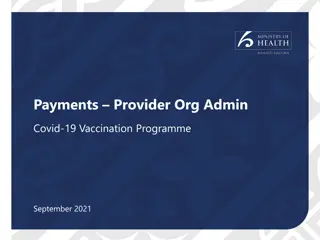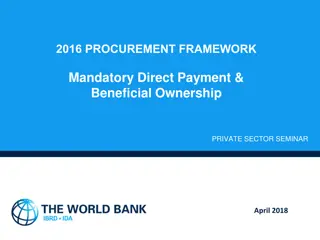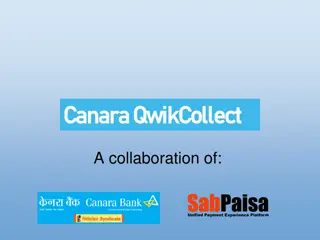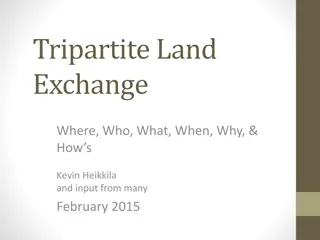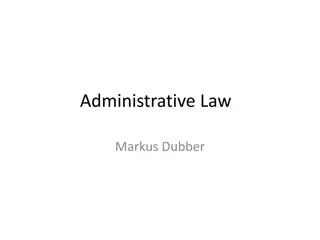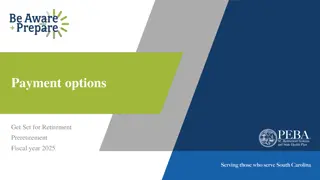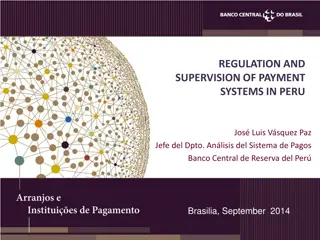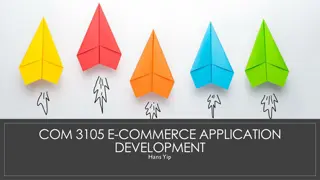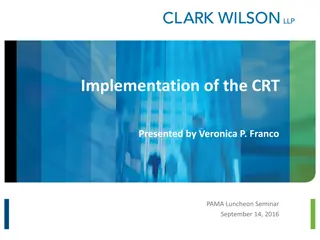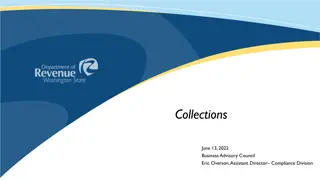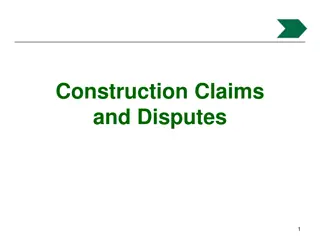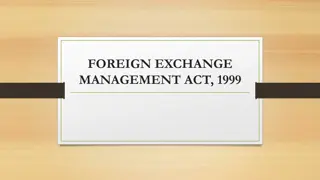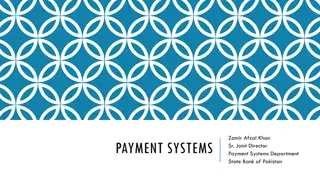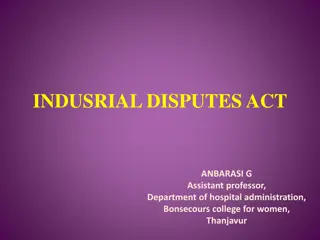State-Based Exchange (SBE) Payment Disputes: Overview and Process
The State-Based Exchange (SBE) Payment Dispute process allows issuers to dispute discrepancies in monthly payments through the submission of the SBE Payment Dispute Form to CMS. This process involves identifying and disputing payment amounts related to enrollment data, premiums, tax credits, and more. Disputing payments is crucial for addressing processing errors, timing issues, and enrollment discrepancies, ultimately aiding in the reconciliation process and ensuring payment accuracy. The SBE Disputes Process Flow outlines the steps involved in resolving payment disputes.
Download Presentation

Please find below an Image/Link to download the presentation.
The content on the website is provided AS IS for your information and personal use only. It may not be sold, licensed, or shared on other websites without obtaining consent from the author. Download presentation by click this link. If you encounter any issues during the download, it is possible that the publisher has removed the file from their server.
E N D
Presentation Transcript
State Based Exchange (SBE) Payment Disputes Transition Issuer Training Call #1 Coverage Year 2022 SBE Disputes Team SBEERRSupportCenter@Cognosante.com 855-591-7113
Agenda Overview SBE vs Issuer Responsibilities Identifying Discrepancies Timing SBE vs FFE Disputes CMS zONE Up Next Q&A Resources 2
Overview CMS established the State Based Exchange (SBE) Payment Dispute process to allow SBE issuers to dispute discrepancies with monthly payments as part of the Policy-Based Payment process. The SBE Payment Dispute process allows issuers to identify missing, unexpected, and incorrect payments. 3
What is a Payment Dispute? A SBE Payment Dispute notifies CMS when an SBE issuer has identified a discrepancy between their issuer data and the PPR or HIX 820 data. SBE issuers compare their enrollment and payment data to the data sent by CMS in the PPR and HIX 820 each month. If an issuer identifies discrepant payment amounts, the issuer can dispute those payments by submitting the SBE Payment Dispute Form to CMS. SBE issuers may dispute coverage start date, end date, total premium, Advanced Premium Tax Credit (APTC), and Cost Sharing Reduction (CSR) amounts for any policy-level payment data in a Preliminary Payment Report (PPR) or HIX (Health Insurance Exchange) 820. 5
Why Disputing is Important The SBE dispute process serves several important functions, including: Identification of possible payment processing issues Identification of errors in PPR or HIX 820 file processing Identification of timing issues Identification of persistent enrollment discrepancies Tracking and reporting to CMS on the efficacy of the SBE reconciliation process Logging of payment discrepancies in support of CMS s annual payment accuracy attestation process Note: While issuers send disputes to CMS, CMS does not resolve disputes. Any discrepancies in enrollment and payment data must be resolved between the SBE and the issuer. 6
SBE Disputes Process Flow The issuer submits an SBE Payment Dispute for any payment discrepancy. The ER&R Disputes team processes the data using automated rules and sends the response file to the issuer. The ER&R Disputes team reprocesses the disputes when the monthly EPS Extract file(s) is loaded. The ER&R Disputes team sends the Dispute Disposition Report (DDR) to the SBE on the second business day of the following month. The issuer submits new and unresolved discrepancies. 7
What is the Issuers Responsibility? The issuer should continually reconcile their enrollment data for policyholders and dependents to ensure that all records match with the state. The issuer is responsible for working with the SBE to resolve any enrollment discrepancies. The issuer is encouraged to identify discrepancies between PPR or HIX 820 data and their internal data via the CMS disputing process. The issuer may submit SBE Payment Disputes to notify CMS of payment discrepancies, which may indicate problems within the CMS payment system or issues with SBE enrollment data reported on the SBE Incoming (SBMI) file provided to CMS. 8
What is the SBEs Responsibility? SBEs should continuously reconcile their enrollment data with issuers to ensure that all records match. SBEs are encouraged to utilize the Dispute Disposition Report (DDR) and State Specific Report (SSR). Work with issuers to resolve the outstanding payment discrepancies (i.e., persistent disputes) during their reconciliation processes when applicable. SBEs should submit any updated enrollment information on the SBMI files to ensure that issuers receive corrected payments and to provide CMS with the most current and accurate information. 9
Identifying Discrepancies The PPR or HIX820 data serves as the basis of an SBE Payment Dispute. SBE issuers should review the reports and identify payment records that do not agree with the payments they were expecting based on their internal enrollment records. Any discrepancies should be reported to CMS through the CMS Payment Dispute process. The Enrollment and Payment System (EPS) Extract is a monthly extract of the SBE Enrollment data. The EPS Extract provides issuers and SBEs with a snapshot of the policy-level enrollment data that forms the basis for payments one month before the payments are made. The EPS Extract includes a complete history for a coverage year. Due to timing of the PPR/HIX820, an issuer may opt to validate/confirm any payment discrepancies against more current information in the EPS Extract to determine if the discrepancies are still valid before submitting to CMS. Note: Disputes received prior to the receipt of the monthly EPS Extract will be reprocessed and any new dispositions will be reported on the Semi-Monthly Report. 10
Ideal Dispute Submission Window Submitting a dispute during the ideal dispute window will: Reduce the volume of dispute disposition reports Reduce the likelihood of work being done on a dispute that may have already been resolved and gets re-dispositioned as a timing issue. Disputes can be submitted at anytime, but if submitted outside the ideal dispute submission window, all disputes will be run through two separate disposition processes. The Semi-Monthly Report will run with that month s most current enrollment data. 12
SBE Versus FFE Disputes File Naming Convention Historical FFE disputes should continue using current file naming convention. TPID.COG.ERRP.Dyymmdd.Thhmmssmmm.P.IN SBE disputes require the use of a different function code in file naming convention. TPID.COG.ERRSBM.Dyymmdd.Thhmmssmmm.P.IN User Fee FFE can dispute user fee. SBE disputes do not include a user fee. Dispute Resolution FFE workstream has access to more data sources so when disposition calls for action on the FFE side, it goes directly into a resolution system. SBE disputes resolution occurs between the issuer and the SBE. 13
CMS zONE 14
Step 1: Create IDM User Account Navigate to the sign in page at https://home.idm.cms.gov/. Select New User Registration. Follow the instructions to complete registration. A message indicating that a new account has been created will appear. Select Return to return to the sign in page. NOTE: Access the IDM User Guide at https://www.cms.gov/files/document/idm- user-guide.pdf. 15
Step 2: Request Access to zONE Log into the IDM system at https://home.idm.cms.gov/. On the IDM Self Service page, select Role Request. From the application menu, select zONE: Opportunity to Network and Engage. From the role menu, choose Select a role to complete the request. (typically zONE End User) 16
Step 3: Request Community Access in zONE Upon receiving access to zONE, log in using IDM credentials at https://zone.cms.gov/. Select Browse Communities from the main screen or from the Communities drop-down menu. Locate the Issuer Community Private option and click Request Community Membership. Submit the requested information. NOTE: Access the zONE End User Access guide at https://zone.cms.gov/document/zone- end-user-access-guide. 17
Next in the SBE Payment Dispute Training Series The SBE Payment Disputes Transition Issuer Training Call #2 will cover a deep-dive into how to submit disputes and what is expected from the issuers. Cognosante recommends the issuer include representatives from the following departments: Issuer Payment Disputes IT Enrollment Payment/Billing 18
Q&A Questions? 19
SBE Payment Dispute Resources For technical assistance or for assistance with questions or concerns regarding the SBE Payment Dispute process, please contact the SBE ER&R Support Center: SBEERRSupportCenter@Cognosante.com 855-591-7113 NOTE: Issuers should identify themselves as SBE issuers when contacting the ER&R Support Center. 20
SBE Payment Dispute Resources Access the following SBE resources for more information: SBE Issuer Landing Page: https://zone.cms.gov/wiki/sbm-issuer-information State Based Exchange Technical Reference Guide (TRG): https://zone.cms.gov/document/sbe-payment-disputes-technical-reference-guide SBE Payment Dispute Form: https://zone.cms.gov/document/issuer-dispute-form SBM Dispute and Disposition Code List: https://zone.cms.gov/document/sbm-disputes- disposition-and-detail-code-list Overview of State Based Marketplace Policy Based Payment Files: https://zone.cms.gov/system/files/documents/sbm_pbp_files_chart_021517.pdf 21


